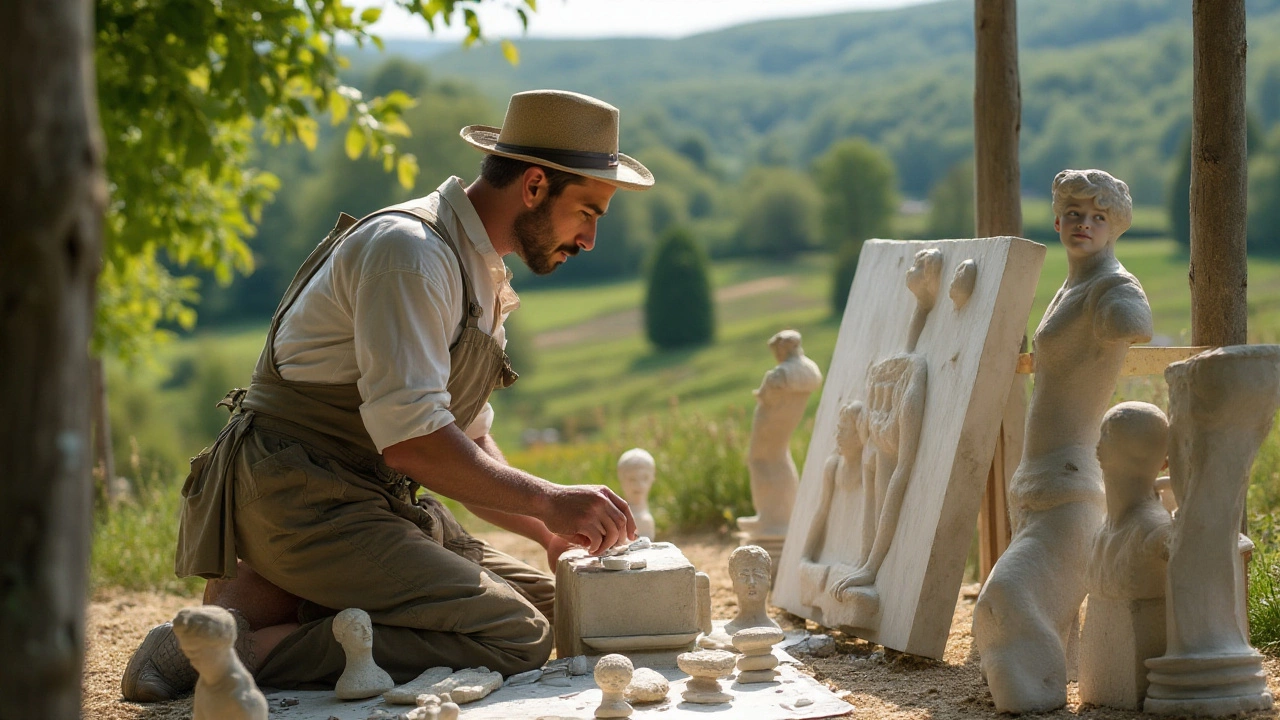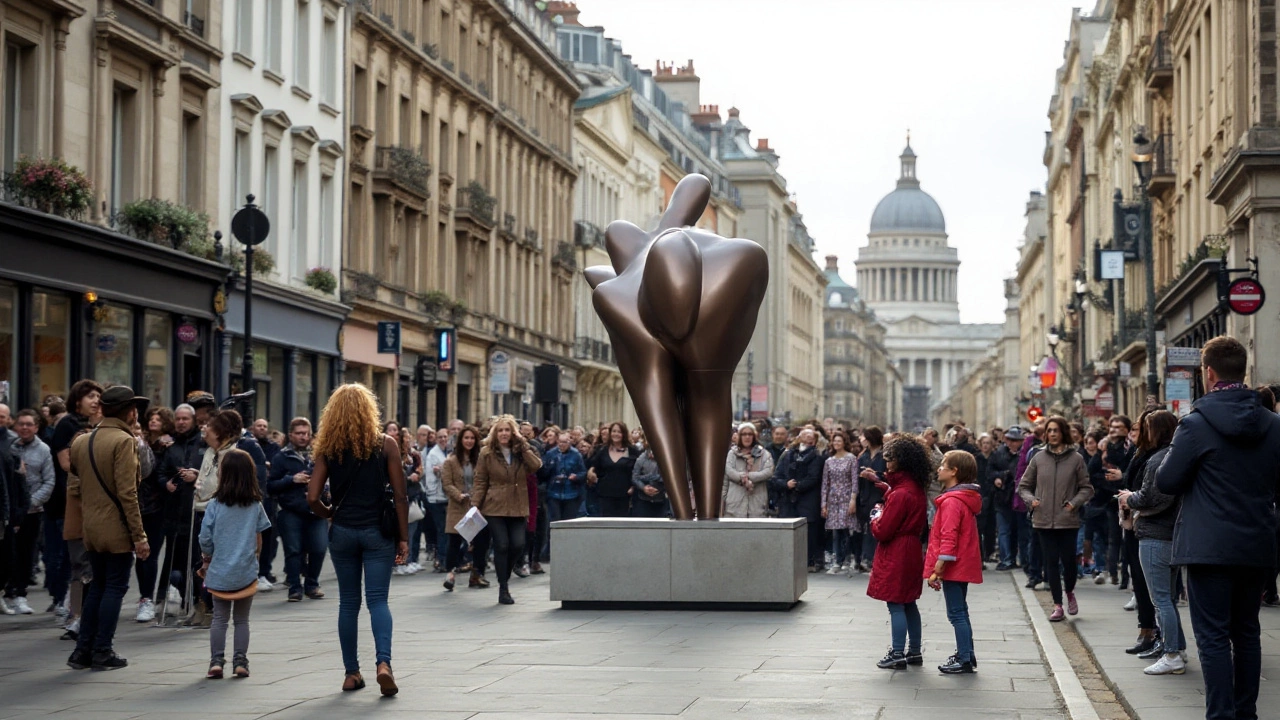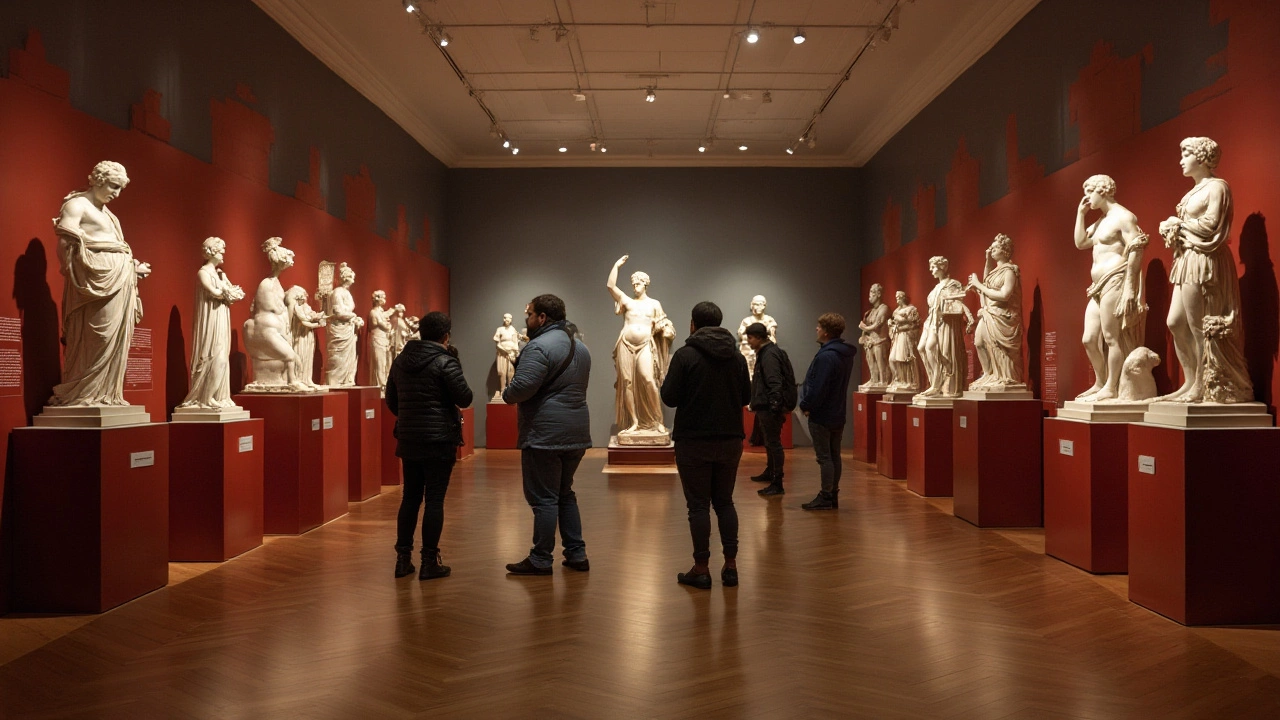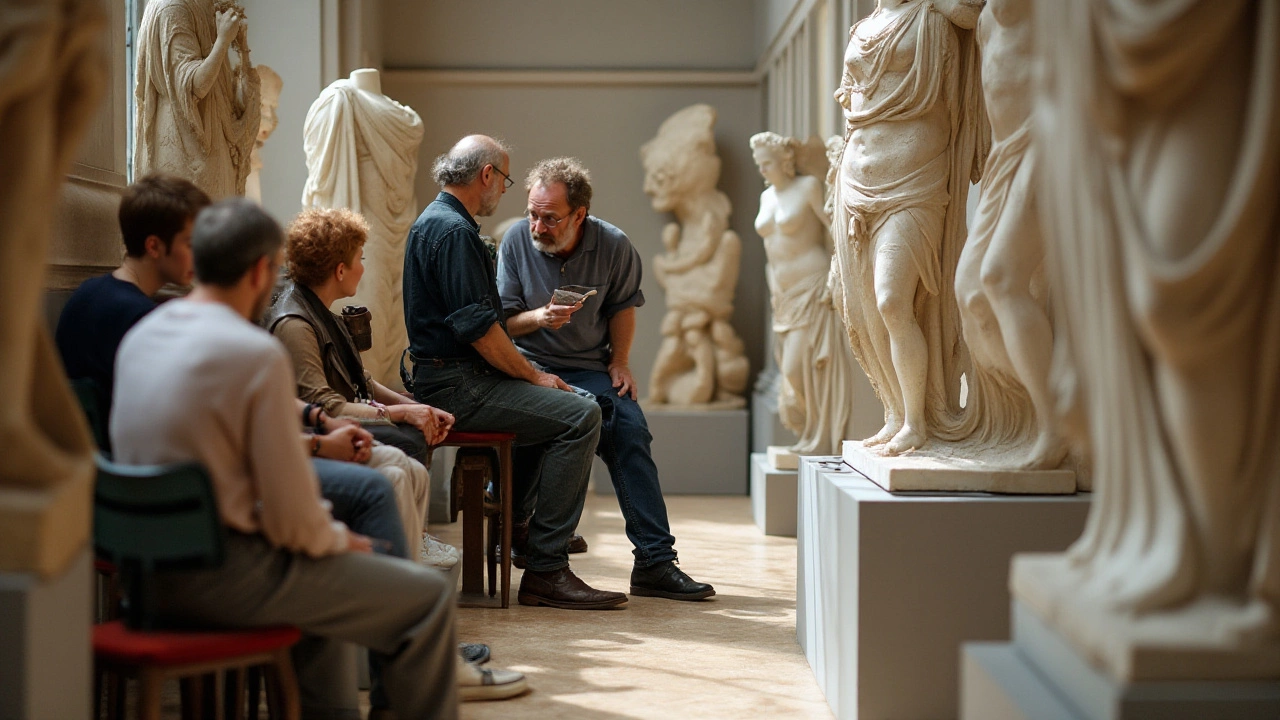Sculpture has long captured the human imagination, offering a glimpse into the soul and spirit of creativity through its tangible forms. The tactile experience of carving, molding, or assembling shapes channels an artistic dialogue spanning centuries.
It's challenging to single out one sculptor as the ultimate best. Each significant figure in sculpture art has contributed uniquely to this rich tapestry, evolving styles, techniques, and cultural statements through time. From the chiseled beauty of classical statues to the dynamic abstractions of modern installations, these artists have left an indelible mark on the history of art.
Classical Era Sculptors
The Classical Era stands as a pinnacle in the history of sculpture art, a time when perfection of form and balance was esteemed. Greek and Roman artisans of this era endowed the world with iconic works that continue to inspire awe. Consider the likes of Phidias, whose artistry in crafting the majestic statues of Zeus at Olympia and Athena Parthenos was renowned across the ancient world. These masterpieces were celebrated not only for their grandeur but also for the intricate detail and expression they embodied.
Another towering figure from this age, Polykleitos, authored the 'Canon', a treatise outlining the principles of symmetria—the ideal mathematical proportions he believed led to aesthetic beauty. His sculpture 'Doryphoros' or 'Spear Bearer' exemplifies these ideas, rendered in a poised contrapposto stance that gives the figure life-like elegance. This technique would influence countless artists beyond his own era, embedding a legacy that lived through the Renaissance and into modern art.
In the Roman spirit, an artist like Praxiteles introduced a softer and more naturalistic approach with his sculptures, pushing the boundaries of depicting human beauty. His famous 'Aphrodite of Knidos' is celebrated for its unprecedented portrayal of the nude female form, capturing serene grace while embracing a level of sensual realism previously unexplored. These figures not only represented gods and heroes but became an opportunity to explore human emotion and physical expression.
"Art is the lie that enables us to realize the truth." – Pablo Picasso
The Classical sculptors also pioneered the use of various materials, including marble and bronze, allowing them to experiment with scale and detail in new ways. Marble offered a tactile softness and luster, while bronze allowed for more dynamic and complex compositions because of its strength and durability in casting methods. This flexibility in material choice supported their ambitious creative visions, setting an enduring standard for craftsmanship.
By studying these ancient masters, modern enthusiasts and artists gain valuable insights into the mastery of sculpture art. Their work embodies timelessness, a testament to human creativity and the enduring quest to understand and celebrate our existence through art. Their legacy ensures they remain pivotal figures in art history, their techniques and ideals timelessly captured in the heart of culture itself.

Renaissance Masters
The Renaissance era marked a significant transformation in the art of sculpture, unfurling a new chapter that celebrated humanism and a renewed interest in classical antiquity. During this awe-inspiring period, artists gained eminence by marrying technical precision with profound expression, an art form that redefined the perception of beauty. Among the noteworthy sculptors of this time, Michelangelo stands out with his remarkable ability to breathe life into stone, creating works of art that have captivated audiences for centuries. His masterpiece, David, epitomizes the Renaissance ideal of the perfect human form, capturing the aesthetic canons drawn from the study of nature and human anatomy.
Lorenzo Ghiberti also played a pivotal role in sculpting the Renaissance narrative with his creation of the Gates of Paradise for the Florence Baptistery. These intricate bronze doors portray scenes from the Old Testament, exhibiting an unparalleled depth and detail that were revolutionary at the time. Ghiberti's work influenced his contemporaries and set a benchmark for art history. Donatello, another giant of the era, pioneered techniques that gave way to a more naturalistic style. His bronze sculpture of David introduced the concept of contrapposto posture, a dynamic stance that added a sense of fluidity and movement, breaking away from the static representations of the past.
It's essential to appreciate how these famous sculptors were deeply entwined with the intellectual and philosophical currents of their time. The Renaissance wasn't just about art; it was a movement that championed the rediscovery of the ancient world and the burgeoning curiosity about the human condition. Sculptors embraced this spirit of inquiry, exploring themes of religion, mythology, and humanism in their works. A notable factor in the evolution of art during this period was the patronage of influential families like the Medici, who fueled the growth of culture and arts, making Florence the heart of the Renaissance.
"A man's work is his window to the world," observed Vasari in his book 'Lives of the Artists', highlighting how Renaissance sculptors left impressions of their worldviews in their creations.
The Renaissance offered a fertile ground for innovative techniques, including linear perspective and anatomical accuracy, which sculptors adopted from their painter counterparts, leading to an enriched, multi-dimensional form of representation. This period of rebirth, or 'rinascita', as referred to by Italians, provided the perfect backdrop for sculptors to experiment, inspire, and impact generations of artists to follow. The legacies of these masters have left an indelible impact on both past and present artists, providing a reference point for innovation and excellence.
As we delve deeper into the works of these masters, one can't help but be astounded by their relentless pursuit of perfection and the divine. The reverence they held for nature and the human body echoes throughout their creations. Through their sculptures, the Renaissance Masters have bequeathed an art form that continues to inspire and evoke admiration, embodying a timeless enchantment that speaks to the essence of what it truly means to be human.

Modern Visionaries
The 20th and 21st centuries have ushered in a new league of sculptors, fondly referred to as modern visionaries, who dared to push boundaries and redefine art. These artists embraced abstraction, incorporated unconventional materials, and tackled contemporary narratives that resonated with audiences worldwide. Their works aren't merely confined to galleries; they've seamlessly entered public spaces, transforming landscapes and everyday environments. This era of sculpture art witnessed the fusion of innovative technology and timeless techniques, resulting in pieces that challenge norms and provoke thought.
Barbara Hepworth is one such figure, whose organic, flowing forms redefined the perception of space and form in the art world. Her sculptures, often inspired by her surroundings, particularly the rugged beauty of Cornwall, exhibit a harmonious balance between mass and void. This integration of positive and negative space, along with her unique use of piercing, allowed viewers to experience a delightful spatial interplay. Hepworth believed in the spiritual connectivity of people through art, declaring,
"Sculpture communicates an immediate sense of life – you can feel the pulse of it."Her belief in the intrinsic human connection is evident in her enduring masterpieces, which continue to attract and inspire spectators even today.
Another pivotal name is that of Jeff Koons, who has consistently intrigued the art world with his bold, provocative creations. His approach combines popular culture and fine art, crafting pieces that engage the viewer with vivid colors and often eccentric form. Koons's inflatables, for instance, playfully explore themes of consumerism and artifice, bringing a touch of whimsy and nostalgia into the often solemn art discourse. Despite receiving mixed opinions, his sculptures spark significant dialogue about commercialism in art, making them particularly relevant in today’s society. Koons insists that, "art is not about exalting the medium or artist, but about the viewer's perception and enjoyment."
Then there are artists like Anish Kapoor, whose boundary-defying works often make use of materials such as wax, pigments, and even reflective surfaces to explore themes of absence, void, and the infinite. One of his most notable installations, Cloud Gate, affectionately known as 'The Bean', in Chicago's Millennium Park, has become a cultural icon, inviting viewers to interact both physically and introspectively. The smooth, reflective curve of the sculpture captures the skyline, translating the urban environment into a surreal, distorted delight. Such works provoke inquiry into the relationship between form, space, and the viewer's interaction with these elements.
The emergence of digital technology and AI has opened new creative possibilities for these modern visionaries. The playful integration of these tools with traditional techniques has given rise to interactive and kinetic sculptures, setting the stage for future explorations. As the world accelerates towards innovation, sculpture art remains at the forefront, with its compelling narrative constantly being reshaped by the remarkable visionaries who dare to dream beyond the conceivable.

Contemporary Innovators
In today's vibrant art scene, sculpture art embraces an eclectic collection of visionary innovators who are reshaping the boundaries of traditional and modern aesthetics. These artists are not just molding materials; they are crafting dialogue between the past and the present, and their work often blurs the line between creativity and commentary. One such artist is Anish Kapoor, whose exploration of voids and negative spaces has turned heads around the world. Kapoor's work with reflective surfaces, particularly his famous "Cloud Gate" in Chicago, invites viewers to see themselves within the art, echoing the theme of self-reflection and identity.
Another leading light in the contemporary sculpture realm is Jeff Koons. Known for his bold and playful use of popular culture references, Koons' oversized balloon animals challenge the notions of consumerism and the art establishment. His pieces, often provocative and larger than life, provoke dialogue about art's place in public and private spaces. In a world dominated by rapid digitalization, artists like Koons remind us of the tactile joy and simplicity in art, bringing an almost childlike wonder into complex commentary.
Then there’s Yayoi Kusama, whose whimsical yet profound installations have enchanted and mesmerized art lovers worldwide. Through her work with dots and bright colors, Kusama creates immersive environments that evoke both playful curiosity and existential introspection. Her installations, such as the "Infinity Mirror Rooms," invite viewers into a seemingly endless realm, illustrating the expansive nature of self and the universality of human experience. In today's growing focus on mental health and awareness, Kusama’s art takes on an additional layer of significance and empathy.
In the field of art history, these artists not only contribute to its expansion but redefine it by breaking existing paradigms. They are experimental, sometimes controversial, and always daring, playing a vital role in how we consume and interpret art. Their innovative techniques and thematic boldness invite us to question what sculpture can be and should be in a rapidly changing world. Each piece is more than a mere tribute to craftsmanship; it is a tangible expression of contemporary human issues, a mirror to our collective identity.
"Art is not freedom from discipline, but disciplined freedom." - John F. Kennedy

